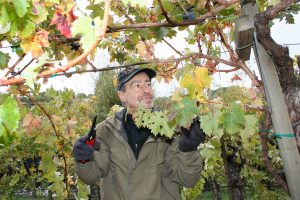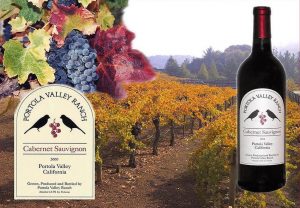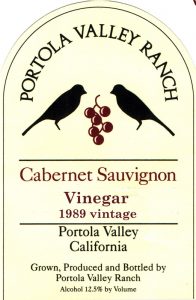
Harvesting grapes in the ’90s.
One unusual feature of our 200-home planned community, Portola Valley Ranch, is tucked on a gentle slope above the tennis courts, orchard, and duck pond: half an acre of cabernet sauvignon and merlot grape vines.
How can I convey the childish joy of wading around the tubs as the grapes squished and squirted between our toes?
Our community vineyard is maintained through the year by our resident Wine Committee and landscaping staff, consulting with a local oenologist. Sometime in October, however, when the Brix (sugar content) is right but (ideally) before the first rainstorm of the winter season, they send out a call for the harvest. And we all show up bright and early, gardening clippers in hand, to pick the grapes.

A chilly morning harvest in 2011.
The actual harvest—the fun part—only takes about an hour, as we fan out into the rows of vines. The committee tells us whether to pick the small secondary bunches as well as the larger primary ones. There’s an art to maneuvering your clippers into the tangle of tendrils without piercing or crushing the grapes, then snipping at just the right point so that the ripe bunch falls gently into your other hand. Of course, we have to sample a few of the small, swollen grapes to make sure they’re sweet enough, juicy enough—then spit out the tiny, hard seeds. We drop the bunches into yellow bins called lugs, which we (indeed) lug to the street to be loaded into a pickup truck and carted a hundred yards to our tiny winery.
Which is where we finally go, when all the grapes are picked, to stem them. We don surgical gloves and stand for a couple of hours at rectangular tables and rip the grapes from their bunches, this time trying deliberately to break their skins for easy crushing. This is the tedious part, as we slowly convert each lug of picked bunches into lugs of grapes for crushing and stems for composting. Still, it’s a good opportunity to meet new neighbors, catch up with old ones, and gossip about those who have had the bad judgment not to show up. These days our conversations generally avoid politics, although it’s a liberal California community. No use spoiling a perfect day.
When we first arrived in 1987, the stemmed grapes were dumped into tubs and we crushed them in the classic way, stomping on them with bare (and hopefully washed) feet. How can I convey the childish joy of wading around the tubs as the grapes squished and squirted between our toes? Alas, a couple of years later we bought a commercial crusher, which was apparently better for the wine (and more efficient). For a few years they maintained a “Kiddie Krush” where children could crush grapes in a wading pool, which was way cute but didn’t last.

Our wine label and the vineyard in fall.
When all the grapes are stemmed and crushed and the mess hosed off, we finally retire to the Ranch House (community center) for a convivial lunch of lasagna or pulled pork, salad, cookies, and of course previous vintages of our wine. It’s one of those meals given extra flavor by a morning of hard (or at least diligent) physical work.
But the harvest is just the start of the winemaking process. The committee ferments the wine in a massive stainless steel vat and then decants it into oak barrels for aging. Not quite two years later they bottle and distribute it: one bottle to each household, one to each resident who helped with the harvest, and the rest to those who bought shares to help defray the costs. The yield is about a hundred cases.
 And how is the wine? Damn good—with one exception. In 1989, the wine just did not mellow. After collecting enough complaints, the Wine Committee recalled it all and made wine vinegar out of it! Was this related to the Loma Prieta earthquake just a week before the harvest, which shook the San Andreas fault that runs beneath the vineyard land? We’ll never know, but our “earthquake vintage” just proves that farming remains an inexact science.
And how is the wine? Damn good—with one exception. In 1989, the wine just did not mellow. After collecting enough complaints, the Wine Committee recalled it all and made wine vinegar out of it! Was this related to the Loma Prieta earthquake just a week before the harvest, which shook the San Andreas fault that runs beneath the vineyard land? We’ll never know, but our “earthquake vintage” just proves that farming remains an inexact science.
Otherwise, the wine is comparable to Napa and Sonoma cabernets, with enough body to pair with food. Ranch wines have won awards in community wine competitions and friends are always impressed when we bring it to dinner parties. “You made that wine?” they ask with wide eyes. It’s like the extra kick you get when you bite into your own freshly picked, home-grown tomato or strawberry. But, you know, it’s wine.
John Unger Zussman is a creative and corporate storyteller and a co-founder of Retrospect.



Fabulous, John! I learned so much about the wine-making process, and can’t help but conjure up the famous scene of Lucy and Ethel stomping merrily, barefoot, in a vat of grapes. I love that you both did that for a while.
A real sense of community comes across in your piece. At every step of the way you work together toward a common goal, but the best is the lunch at the end, paired with a wine from a prior year and the satisfaction of a job well done and the gratification of sharing and enjoying the fruits of your labor. Salut!
Thanks so much, Betsy. It has been a learning experience for all of us, but the result, as you say, is something we can share that is only enriched by the labor (and story) behind it. I’ll drink to that!
Oh just magical and magnificent John. And Patti’s T-shirt makes me smile. Well done man.
Love those adjectives. I’m blushing now. Thanks, Jennifer.
Great story, John! You posted at the end of the week, so I might have missed it were it not for facebook and twitter! 🙂 Fascinating to learn about your planned community and its vineyard. I had no idea! And, like Betsy, when I read about stomping the grapes, I immediately thought of Lucy and Ethel.
Wish I could have written a story last week, but I had absolutely no garden stories in my repertoire. A week without writing a Retrospect story is like a day without sunshine (or wine)!
Thanks, Suzy. Since both you and Betsy mentioned the clip—but I didn’t remember it—I went straight to YouTube. You’re right, it’s hilarious! The one I found is only Lucy (with, presumably, an experienced local grape-stomper), however. Funny how our minds add details to our memories. https://www.youtube.com/watch?v=fUxjOS3g6Uc
The clip you posted cuts off before the best part, where Lucy and the other woman get into a knock-down, drag-out fight. I haven’t been able to find a good quality version of it on youtube, but I’m sure it’s there. That much I do remember. But it’s surprising that Ethel wasn’t in there with her.
I see what you mean! The version I found is low quality, as you say. But what a fight! I’m reminded of Chekhov’s dictum that if you show a gun in the first act, it has to go off by the third. If Lucy’s wading through grapes in the opening, she has to be wallowing in them by the end. https://www.youtube.com/watch?v=1yIn2PeoZjA
What an interesting story. I learned about wine making, but also about community building. Hope you are still at it.
Thanks, Laurie. We are indeed — although this year’s crop might be damaged by the smoke and ash that currently fills the air. Like any agricultural venture, we farm at the whim of Mother Nature.
Your community sounds lovely, John! And I love community gardens as well, where folks come together in shared purpose and in anticipation of sweet reward. I also appreciated the details on how wine is made. Loved this piece!
Thanks so much, January. It’s true, our community was well planned, and (despite the usual points of friction) very many residents have stepped forward to help make it work. We’re all holding our breath — literally and figuratively — these days out here in the fire-prone “WUI” (Wildland-Urban Interface). Fortunately, we’ve made efforts in the last ten years to become a “firewise” community and it shows.
Wow John, I was waiting for the bare feet and there they were! Praise Bacchus!
It wouldn’t be a winemaking story without the bare feet! Thanks, Dana.
What fun…cheers!